Tajarin al Ragù Bianco di Coniglio {Piemontese Pasta With White Rabbit Ragu}
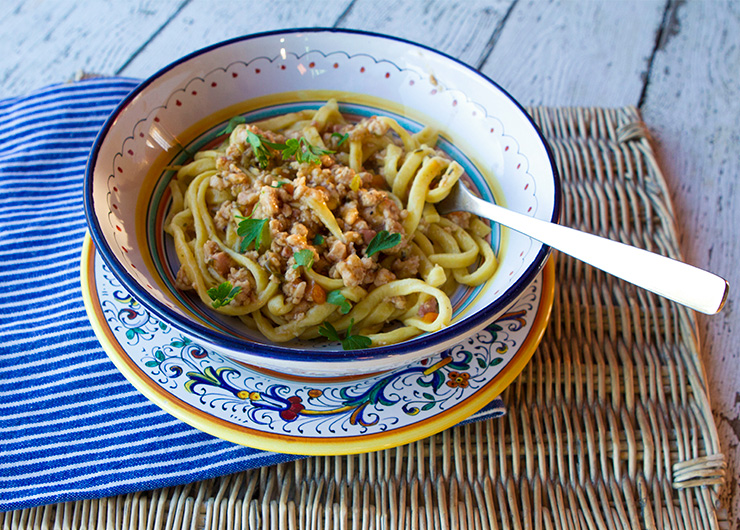
We love to travel throughout Italy as often as possible, and although I enjoy fully exploring new regions, my most memorable experiences that I usually take home with me often revolve around food. We recently spent six nights in Piemonte, and if you have never been to this lovely region in northern Italy, I highly recommend it.
The pasta in particular in Piemonte was truly out of this world. The Piedmontese specialize in stuffed pasta, and a variation of tagliatelle called Tajarin made mostly with egg yolks, and not the whole egg. Tajarin (pronounced “tie-yah-teen”) has a rich flavor, is dark yellow in color and pairs well with hearty meat sauces.
Our first stop on our Piemonte adventure was the town of Cuneo, and although it was pouring rain during our only day there, we managed to explore the town on foot. Cuneo celebrates an illumination festival every July, and the center of the city is blanketed in colored lights every evening.
We often spend a good deal of time choosing our restaurants on our vacations, but I had read about Ristorante Torrismondi in Cuneo before we arrived, and since the reviews were excellent, that was where we dined. We shared two different regional pasta specialties to start, and although the stuffed pasta with eggplant and goat cheese was delicious, we were particularly enamored with the tajarin (tagliatelle) topped with a white rabbit ragu.
I researched the Piemontese version of this pasta and created my own rabbit ragu from my memory of the delicious one we enjoyed at Ristorante Torrismondi. I do not have a tagliatelle cutter here in Italy, so I used my chitarra pasta cutter, and it worked just fine. If you have a pasta machine with a tagliatelle cutter, I’d suggest using that, or if you have the patience, you can always cut it by hand.
The measurements I am posting below are what I needed to make my pasta using the large size egg yolks from my chickens. If your dough seems a little dry, add an additional yolk or even a whole egg if you need to.
For my ragu, I was trying to replicate the one I enjoyed in Cuneo where the rabbit meat had been ground, so I cut the meat off of my rabbit and put it into the food processor to grind it up. If you prefer, you can simply cut the meat off of the rabbit in small pieces instead.
This ragu is a white one, meaning that it isn’t a tomato based sauce, and the meat instead is braised in white wine and chicken stock. The ingredient list may seem long, but once everything has been chopped, the sauce comes together pretty quickly and is then just left to simmer on low for a couple of hours. The sauce and pasta could both be made ahead of time, even the day before, and then refrigerate covered until needed.
Ristorante Torrismondi
Via Michele Coppino 33, Cuneo
Ph 0171 65515
Cell 3289060040
e-mail: [email protected]
Open daily Monday through Saturday for dinner,
Thursday, Friday, & Saturday for lunch.
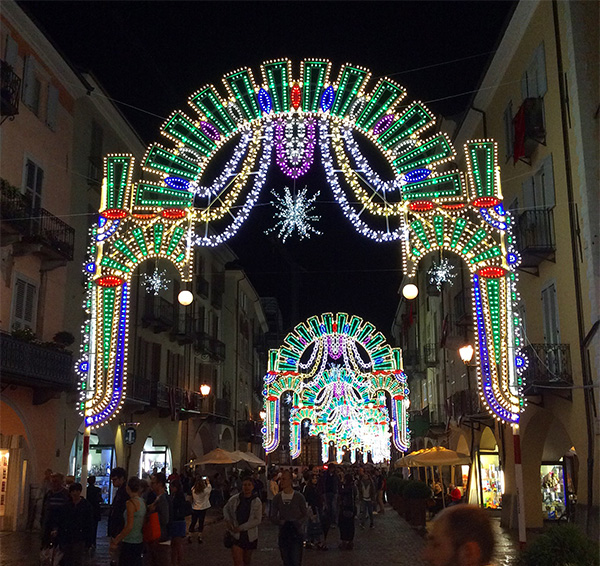
The Light Show In Cuneo.

Tajarin Pasta With Rabbit Ragu From Ristorante Torrismondi in Cuneo.

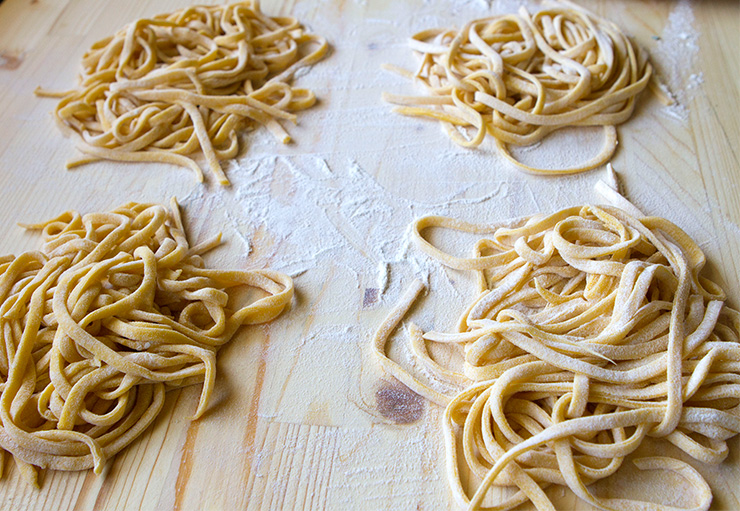
Homemade Tajarin Pasta
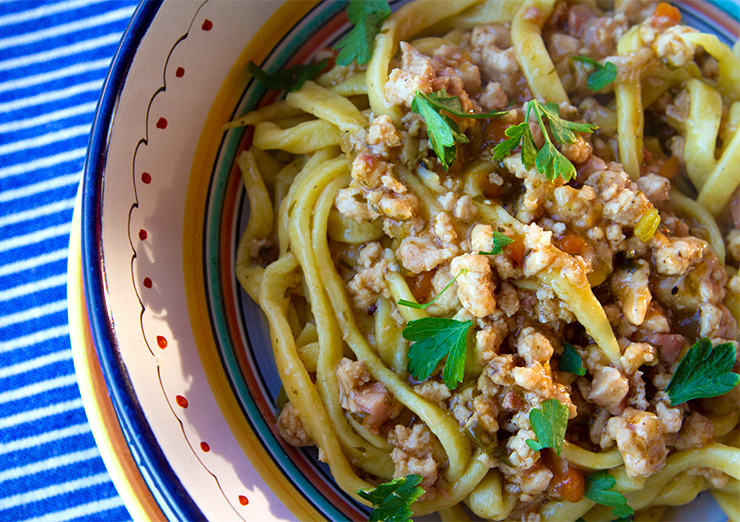
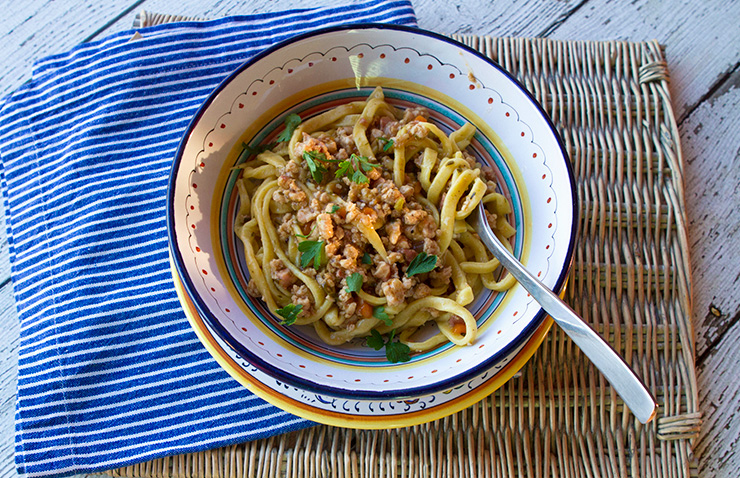
Buon Appetito!
Deborah Mele
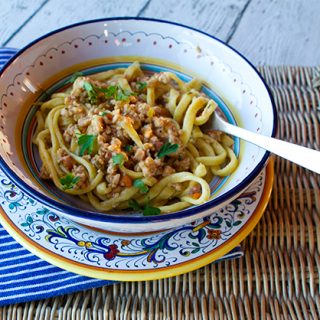
Tajarin al Ragù Bianco di Coniglio {Piemontese Pasta With White Rabbit Ragu}
Ingredients
Tajarin Pasta:
- 2 3/4 Cups All-purpose Flour
- 3/4 Cup Semolina Flour Plus More For Dusting
- 9 Large Eggs
- 1 Tablespoon Olive Oil
White Rabbit Ragu:
- 1 Medium Sized Rabbit
- 3 Tablespoons Olive Oil
- 4 Strips Bacon or Pancetta, Finely Chopped
- 1 Small Onion, Finely Chopped
- 2 Sticks Celery, Finely Chopped
- 1 Medium Carrot, Peeled & Finely Chopped
- 3 Cloves Garlic, Minced
- 2 Tablespoons Tomato Paste
- 2 Cups Dry White Wine
- 1 1/2 - 2 Cups Chicken Stock
- 2 Sprigs Fresh Rosemary
- 1 Teaspoon Dried Oregano
- 1/4 Cup Finely Chopped Fresh Parsley Leaves
- Salt & Pepper To Taste
To Serve:
- Grated Parmesan or Pecorino Romano Cheese
Instructions
- To make the pasta, mound the flour onto a large board, making a hollow in the center.
- Break the eggs one at a time, separating the yolks and whites, and mix just the egg yolks into the flour with a fork.
- Once all the egg yolks have been incorporated into the flour, begin to knead with your hands until the dough is stiff and elastic.
- Cover with plastic wrap and let sit 30 minutes before using.
- When ready to roll the pasta, first break off a fist sized piece of the dough and flatten into a disc.
- Flour well, then pass it through the widest openings of your pasta machine.
- Remove, fold into thirds and repeat.
- Do this 4 or 5 times, dusting with flour between each time.
- Now start to decrease the rollers by turning down one notch each time.
- Put the dough through each setting twice until you have reached your desired thickness. (I stop at #4 on my pasta roller)
- Run the pasta through a tagliatelle (or fettuccine) cutter and gently toss with a little additional semolina flour to prevent sticking.
- Place the dough on a baking sheet lightly dusted with semolina flour and refrigerate until needed.
- To make the sauce, use a sharp knife and cut all of the meat off the rabbit, then cut into 1-inch pieces.
- Place the rabbit meat into a food processor, and pulse until coarsely ground.
- In a large heavy bottomed pan (I use my cast iron Dutch oven), heat the oil over medium heat until lightly smoking.
- Add the rabbit meat and stirring often, cook until no longer pink, about 7 minutes.
- Add the bacon or pancetta and cook until lightly browned.
- Add the onion, celery and carrot, and continue to cook until the vegetables have softened, about 7 minutes.
- Add the garlic and cook another minute or two until fragrant.
- Add the tomato paste, white wine, and 1 1/2 cups of the stock and bring to a boil.
- Reduce the heat to a simmer, and add the rosemary, oregano, salt and pepper, and cover.
- Simmer for two hours, adding additional stock as needed.
- Taste, then adjust seasonings as needed.
- Bring a large pot of lightly salted water to a boil.
- Cook the pasta until it is “al dente”. (Fresh pasta will cook in just a few minutes!)
- Drain the pasta, then return it to the pot.
- Add in a couple of ladles full of the sauce and toss to mix.
- Serve the pasta in individual bowls with a scoop of sauce on top.
- Pass the grated cheese at the table.
The ingredients for the noodles call for egg yolks, but the directions seem to indicate using whole eggs. Which is correct?
If you read the directions, only the yolks are used.